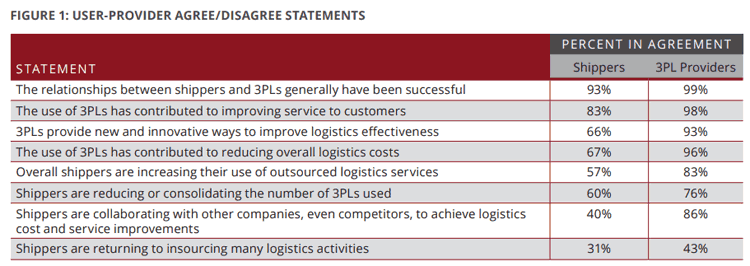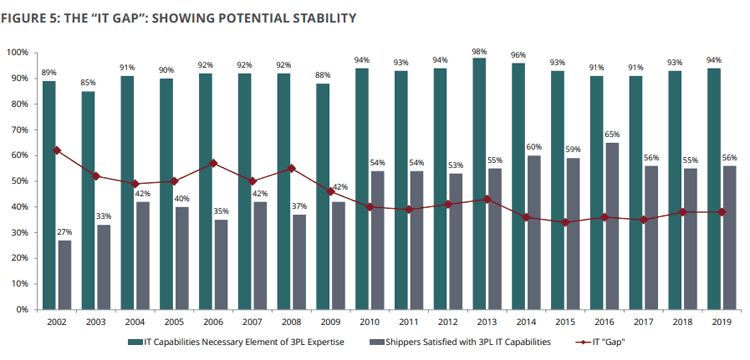Each year in late June, we get the State of Logistics Report from CSCMP, which I summarize under the banner of "The State of the Logistics Union."
Each year in early fall, we get the annual 3PL study, released each year at the CSCMP conference. And so it was again this year with the 2020 study, now in its amazing 24th year, all under the leadership of my friend Dr. John Langley of Penn State.
So this week you get my summary of the 3PL report (we read more so you can read less), which I might as well title the State of the 3PLU union, as it really is a fine compendium of many data points from the logistics service provider sector.
Gilmore Says.... |
 |
| This year, 94% of shippers believe 3PL IT capabilities are a very important factor in success, while only 56% are satisfied with those capabilities. |
 |
What do you say? |
|
| Click here to send us your comments |
| |
|
|
|
In addition to Langley's leadership, this year's report was sponsored by consulting firm Infosys, Penn State and Penske Logistics. Without the sponsors the report wouldn't happen, so they are worthy of some public recognition.
Since I knew I could get a copy of the report later I didn't attend the CSCMP presentation, but I did duck my head into the large session room and it was well attended as is it is every CSCMP. The interest in logistics outsourcing obviously remains high, and nothing pulls the current situation together like this study.
The report is based in part on survey responses from 588 shippers and 3PLs worldwide – down a bit from last year. 46% of those were 3PLs/4PLs, 37% were shippers that use 3PLs, and 17% were shippers that do not use 3PLs – valued for their perspective on why they don't outsource any aspect of logistics.
This year 65% of respondents were from North America, with 8% from Asia and 15% from Europe.
As has been the case for many years, the report again this year focuses on a set of questions and related discussion across a set of issues that mostly stay the same every year (e.g., the famous "IT Gap" - see below), along with a new set of focus topics for this year that get some pages in the repor, usually supported by some additional survey data.
In this year's study, those focus topics are: the use of analytics in 3PL-shipper relationships; supply chain finance; and the "greening" of the supply chain – a good selection of subjects, in my opinion.
I will summarize today the main general data points and insights, and visit the specialty topics in a future column.
The report found that on average total company logistics expenditures as a percentage of sales revenue was the same 11% this year as in the 2018 results. In calendar year 2018, most data points showed significant increases in logistics costs, so this the lack of change is a bit surprising, but respondents taking the survey in earlier in this year may have been factoring in some of 2019, during which transportation costs have been headed down.
The percent of total logistics expenditures directed to outsourcing was slightly higher at 52% in the current study, versus the 51% and 50% reported in the previous two years.
Over the same time frame, the percentage of shippers' transportation spend managed by 3PLs was back at 55%, same as in the 2017 report, after which it somehow decreased to 50% last year. I said at the time it must be a statistical aberration, and with this year's data that appears to be the case.
Meanwhile the percentage of shippers' warehousing spend managed by 3PLs rose sharply to 42% from a drop to 35% lasg year and 39% two years ago.
All that meaning the data last year in part showing declining use of 3PLs was simply a blip.
A very interesting chart in the report shows responses from shippers and 3PLs to a series of questions relative to their relationships – and as can be seen, there are some different perceptions between the two groups.

Source: 2020 3PL Study
The top line in the table showing more than 90% of both shippers and 3PLs believe their relations have been successful is obviously a positive sign for the outsourcing sector.
But as an example discrepancy, almost all 3PLs (96%) believe using 3PLs drives lower logistics costs for shippers, while only 67% of shippers themselves feel that way. Similarly, 66% of 3PL users say that 3PLs provide new and innovative ways to improve logistics effectiveness (down from 73% last year), versus a much higher 93% of 3PLs that believe they are providing that value.
But the largest discrepancy came on the topic of whether shippers are collaborating with other companies, even competitors, to achieve logistics cost and service improvements. A strong 86% of 3PLs agreed, versus just 40% of shippers.
I don't have any explanation for that delta.
Other survey data highlights include:
• 57% of shippers indicate they are increasing their use of outsourced logistics services this year, down from 68% last year. Might be another temporary blip. Conversely, 31% of shippers indicate that they are returning to insourcing many of their logistics activities, up from 28% last year.
• 60% of 3PL users report reducing or consolidating the number of 3PLs they use, about the same as reported last year. Perhaps this long term trend has reached some sort of plateau.
• Why do non-3PL users eschew outsourcing? 32% feel that control over the outsourced functions would diminish; 21% are concerned that cost reductions would not be realized; 15% feel they have more logistics expertise than most 3PL providers; and 13% think it would be too difficult to integrate their IT systems with those of a 3PL.
SCDigest is always interested in the dreaded "IT Gap," which the report has been following for many years. That gap refers to the percentage difference between how shippers place 3PL IT capabilities in terms importance (always very high, usually in the low 90s in terms of percentage), versus their view of actual 3PL IT capabilities, always with a much lower score.
For years the IT Gap had been shrinking, but for reasons that are unclear, it spiked back up in two years ago, and stayed about the same last year and again this year, as shown in the graphic below.

Source: 2020 3PL Study
This year, 94% of shippers believe 3PL IT capabilities are a very important factor in success, while only 56% are satisfied with those capabilities.
The report says that gap has stabilized, but I note it has also taken a step back from 2016.
My view: some 3PLs still try to get by with aging, often home-grown technology that is simply far out of date. There is some complexity here, because if in the middle of a contract with a given shipper or multiple shippers, introducing new technology raises some issues. Even the shipper may not want to upset the apple cart.
But I also believe that many 3PLs that have deployed modern technologies often do not fully use those capabilities or present them in a way most convincing to shippers.
I am out of space. The full report available for free download with registration here.
A look at the focus issues discussed this important research report in another First Thoughts column right here.
Any reaction to this data from the 3PL report? Let us know your thoughts at the Feedback section below.
Your Comments/Feedback
|